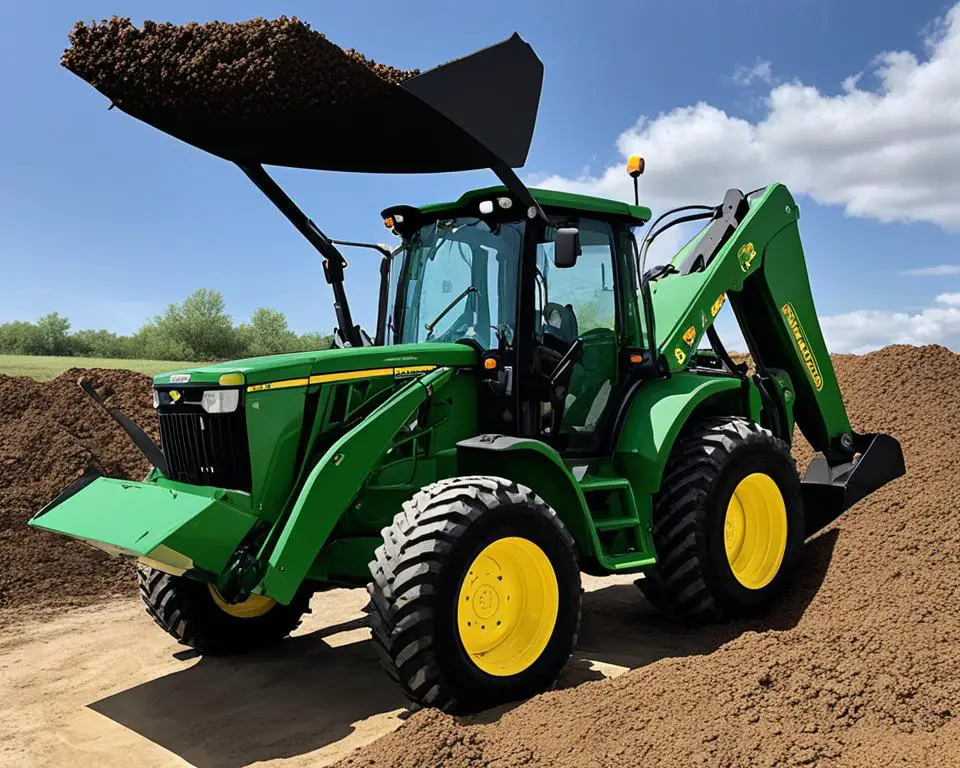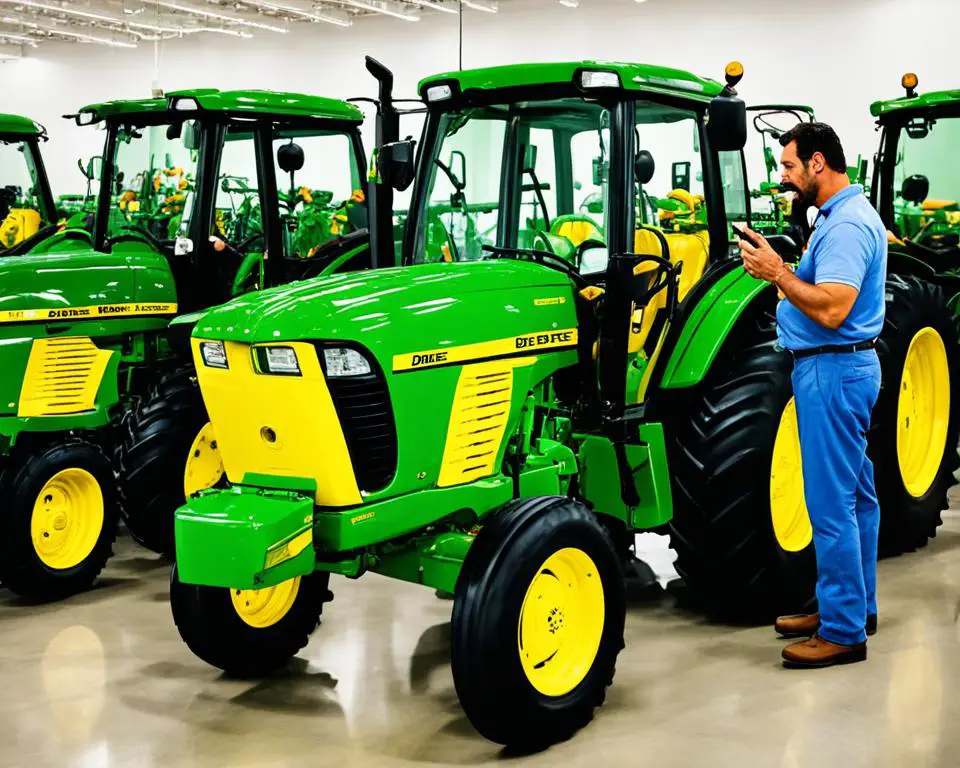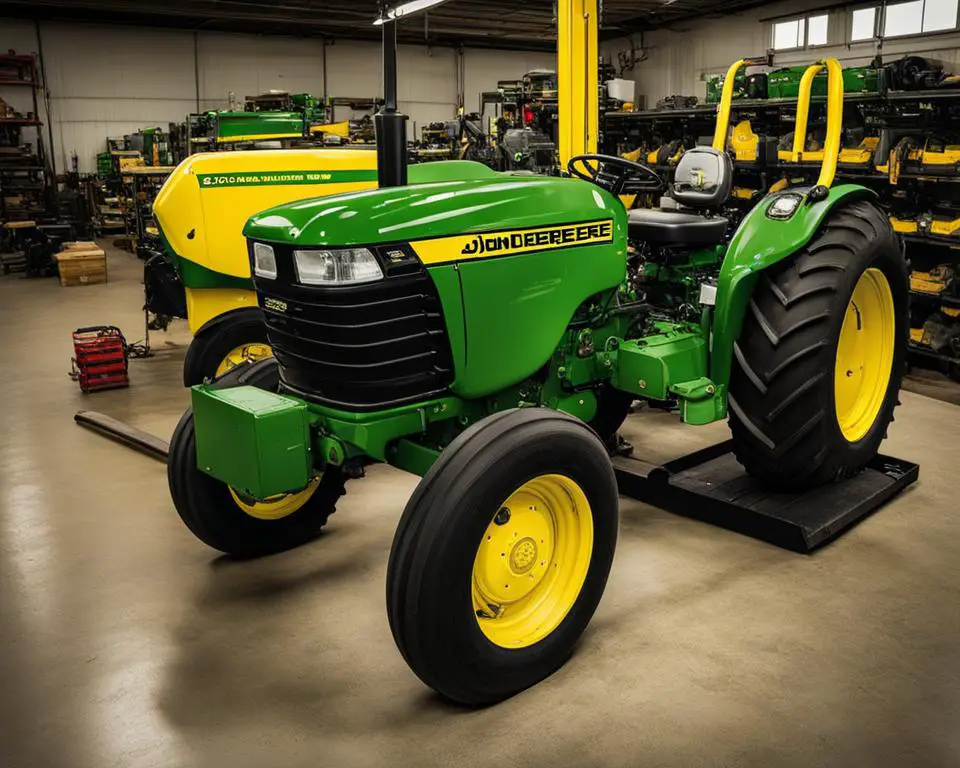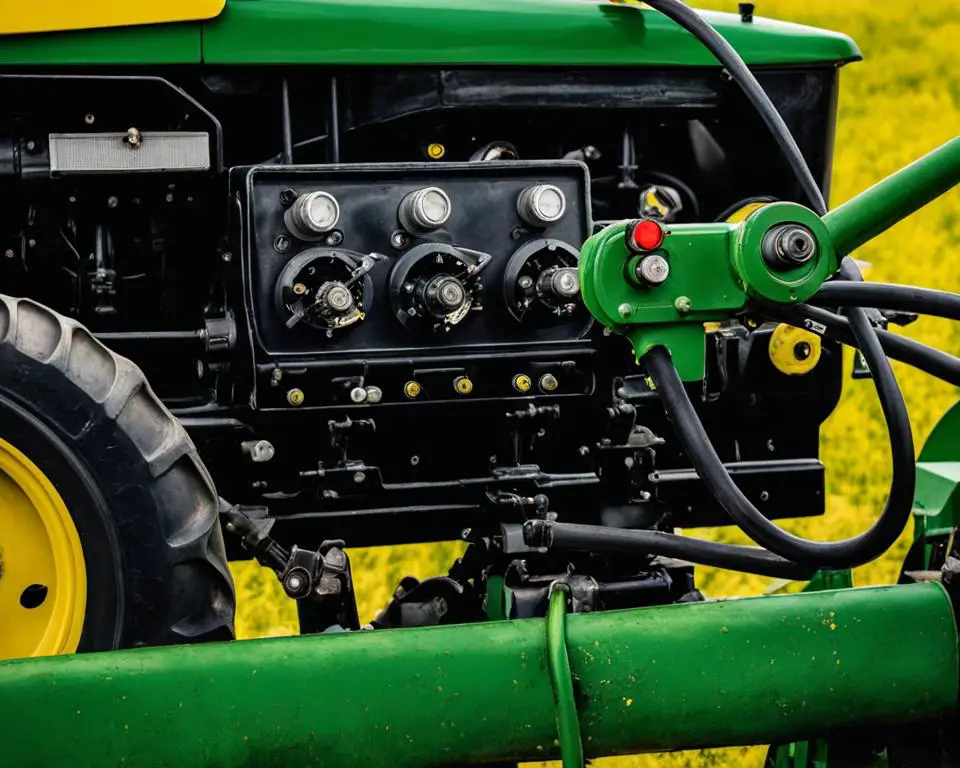Welcome to our comprehensive guide on the common problems and issues associated with the John Deere 4120. As an experienced user, you might have encountered various challenges during your ownership journey. In this article, we aim to address these concerns by providing troubleshooting tips, maintenance advice, and insights to help you achieve optimal performance with your John Deere 4120.
Whether you are struggling with power steering problems, 3-point hitch and loader issues, or facing difficulties with dealerships, we have got you covered. Our detailed analysis will delve into each problem area, offering possible solutions and expert recommendations.
Understanding the importance of regular maintenance, we will also guide you on how to keep your John Deere 4120 in top shape. By following the manufacturer’s guidelines and performing routine inspections, you can prevent potential issues from arising and ensure the optimal performance of your machine.
Furthermore, we will discuss the operator’s manual and other valuable resources available to you. These resources equip you with essential information on maintenance, service intervals, capacities, and safety guidelines, empowering you to make well-informed decisions while operating and maintaining your John Deere 4120.
Stay tuned as we delve into the intricacies of the John Deere 4120, providing valuable insights and practical solutions to help you overcome problems and achieve optimal performance with your machine.
Power Steering Problems
Users of the John Deere 4120 have reported experiencing power steering problems. These issues can greatly affect the operation and maneuverability of the tractor. Some common power steering problems encountered by users include:
- Howling noise when turning the steering wheel
- Intermittent loss of power steering
- Leaking connection at the manifold
To address these power steering problems, there are a few troubleshooting steps that users can take. Firstly, it is recommended to check the hydraulic fluid level and condition. If the fluid is low or dirty, it may affect the performance of the power steering system. Replacing the hydraulic fluid can help alleviate the issues.
Another step is to inspect the power steering filter. A clogged or dirty filter can restrict the flow of hydraulic fluid, leading to power steering problems. Cleaning or replacing the power steering filter, if necessary, can improve the system’s functionality.
If these troubleshooting steps do not resolve the power steering problems, it is advisable to consult with a dealer or authorized technician. They have the expertise to diagnose and resolve more complex issues with the power steering system.
“The power steering problems on my John Deere 4120 were really frustrating. Every time I turned the steering wheel, there was this howling noise, and sometimes I even lost power steering completely. I discovered that there was a leaking connection at the manifold. Replacing the hydraulic fluid and checking the power steering filter made a significant difference. I strongly recommend consulting with a dealer or professional technician for proper diagnosis and resolution of power steering issues.”
| Common Power Steering Problems | Troubleshooting Steps |
|---|---|
| Howling noise when turning the steering wheel | 1. Check hydraulic fluid level 2. Replace hydraulic fluid if necessary 3. Consult with a professional if the issue persists |
| Intermittent loss of power steering | 1. Inspect power steering filter 2. Clean or replace the power steering filter 3. Seek professional assistance if needed |
| Leaking connection at the manifold | 1. Check for any leaks at the manifold 2. Address the leaking connection promptly 3. If the problem persists, consult with a dealer or professional technician |
3PH and Loader Issues
Owners of the John Deere 4120 have also reported problems related to the 3-point hitch (3PH) and the loader. Some users have encountered issues where the 3PH does not stay in place unless the lock knob is tightened. The loader arms and bucket also tend to lift and react slowly, with limited lifting capacity. Additionally, a high-pitched noise is audible from the connections when the machine is under load or minimal stress.
Some users have attempted to resolve these problems by replacing slightly damaged loader hoses and performing a complete drain and refill of the hydraulic system with a new filter. Unfortunately, these measures have not completely resolved the issues at hand. It is advisable for owners to seek professional assistance in order to accurately diagnose the root cause of these problems and find an appropriate solution.

Loader Issues Table:
| Problem Description | Solutions Attempted | Result |
|---|---|---|
| 3-point hitch does not stay in place | Tightening the lock knob | Temporary fix, but problem persists |
| Loader arms and bucket lift slowly | Replacing loader hoses | Partial improvement, but limited lifting capacity remains |
| High-pitched noise from connections under load | Complete drain and refill of hydraulic system with new filter | No significant improvement in noise reduction |
“I’ve tried tightening the lock knob on the 3-point hitch, but it only provides a temporary fix. The loader arms and bucket still lift too slowly, and the lifting capacity is not sufficient for my needs. I’ve also noticed a high-pitched noise coming from the connections, especially when there’s any load on the machine.” – John Deere 4120 owner
To address these issues effectively, it is crucial to consult with professionals who have expertise in John Deere machinery. They can accurately diagnose the underlying problems and recommend the appropriate course of action. Taking proactive measures to resolve 3PH and loader issues will help ensure optimal performance and longevity of the John Deere 4120.
Possible Pump Issues
Based on user experiences, the John Deere 4120 may encounter pump issues that affect its hydraulic system. Specifically, the CH11272 hydraulic pump model has been identified as a potential source of problems. Users have reported the need for a new pump or replacement of pump seals to address these issues effectively.
When experiencing pump-related problems, it is vital to consult with a qualified technician for accurate diagnosis and resolution. They can evaluate the performance of the hydraulic pump and determine whether a new pump or replacement of pump seals is necessary.
If you suspect pump issues with your John Deere 4120, it is recommended to seek professional assistance to ensure proper repair and maintenance of the hydraulic system.
| Common Pump Issues | Potential Solutions |
|---|---|
| Leaking hydraulic pump | Replacement of pump seals |
| Inadequate hydraulic power | New hydraulic pump installation |
| Loss of hydraulic fluid | Repair or replacement of damaged components |
Dealership Challenges
When it comes to resolving problems with the John Deere 4120, some users have encountered frustrating experiences with John Deere dealerships. Customers have reported delays in addressing warranty issues, poor customer service, and even incidents of subpar workmanship during repairs. These challenges can be immensely frustrating and hinder the resolution of problems.
Choosing a Reputable Dealership
Researching and selecting a reliable John Deere 4120 dealership is crucial to ensure a smooth resolution of issues. Take the time to read reviews, seek recommendations from fellow John Deere 4120 owners, and inquire about the dealership’s reputation in addressing warranty concerns. By choosing a reputable dealership upfront, you can minimize the possibility of encountering unnecessary challenges in the future.
Direct Communication for Satisfactory Resolution
When facing warranty issues or concerns with your John Deere 4120, it is important to communicate directly with the dealership. Clearly express your concerns, provide specific details about the problem at hand, and emphasize the importance of a satisfactory resolution. Effective communication can help expedite the process and ensure that your concerns are heard and addressed promptly.
Escalating Issues when Necessary
If you find that your concerns are not being adequately addressed or resolved by the dealership, consider escalating the issue to higher levels of management or contacting John Deere’s customer service directly. Providing documented evidence of your interactions, such as emails or repair records, can strengthen your case and demonstrate the extent of the problem.
Dealing with dealership challenges can be a frustrating part of resolving problems with the John Deere 4120. However, by conducting thorough research, communicating directly with the dealership, and escalating issues when necessary, you can increase the likelihood of a satisfactory resolution and get back to enjoying the optimal performance of your John Deere 4120.

Proper Maintenance and Troubleshooting
Proper maintenance and troubleshooting are vital for ensuring the optimal performance of your John Deere 4120. By following recommended maintenance practices and promptly addressing any issues, you can keep your machine running smoothly and avoid potential problems down the line.
Maintenance Tips for John Deere 4120
To maintain your John Deere 4120, it is important to perform regular maintenance tasks to keep the machine in top condition:
- Fluid Changes: Regularly check and change fluids such as engine oil, transmission fluid, and hydraulic fluid as per the manufacturer’s guidelines. This helps prevent contamination and maximizes component lifespan.
- Filter Replacements: Replace filters, including oil filters, fuel filters, and air filters, at recommended intervals to ensure proper filtration and prevent damage to engine components.
- Inspections: Regularly inspect your John Deere 4120 for any signs of wear, leaks, or loose connections. Pay attention to critical areas such as hydraulic lines, hoses, and electrical connections.
By performing these maintenance tasks on a regular basis, you can proactively address potential issues and maintain the optimal performance of your John Deere 4120.
Troubleshooting Steps for John Deere 4120
When troubleshooting your John Deere 4120, there are specific steps you can take to identify and address any problems:
- Check for Leaks: Inspect hydraulic lines and components for any signs of leaks or damage. Leaks can cause a decrease in performance and potential damage if left unattended.
- Inspect Hydraulic Components: Evaluate the condition of hydraulic components such as cylinders, pumps, and valves. Look for any signs of wear, corrosion, or malfunctions that may be affecting the machine’s performance.
- Listen for Abnormal Noises: Pay attention to any unusual noises coming from the engine, transmission, or hydraulic system. These noises can indicate underlying issues that require further investigation.
Seeking professional assistance from a qualified technician is recommended when troubleshooting your John Deere 4120. They can provide expert guidance, diagnose complex issues, and ensure proper resolution.
Remember, proper maintenance and troubleshooting are crucial for maintaining the optimal performance of your John Deere 4120. By following recommended practices and promptly addressing any issues, you can enhance the longevity and reliability of your machine.

Operator’s Manual and Resources
The operator’s manual for the John Deere 4120 is an invaluable tool for owners, providing comprehensive information and guidance for maintaining and operating the machine. It contains detailed instructions on maintenance procedures, service intervals, capacities, and essential safety information. By referring to the operator’s manual, owners can ensure that they are performing maintenance tasks correctly and adhering to recommended service schedules.
“The operator’s manual is a treasure trove of knowledge. I rely on it whenever I need to troubleshoot or perform maintenance on my John Deere 4120.” – Robert, owner of a John Deere 4120
In addition to the operator’s manual, there are other resources available to assist owners in maximizing the performance and longevity of their John Deere 4120. Authorized John Deere dealerships can provide further expertise, advice, and support. These dealerships also offer genuine John Deere parts and accessories, ensuring that owners have access to high-quality components for their machines. Online forums and communities of John Deere owners can also be valuable sources of information and practical tips.
Maintenance Information
The operator’s manual contains detailed maintenance information specific to the John Deere 4120. This includes guidelines for fluid changes, filter replacements, lubrication points, and other routine maintenance tasks. Following these recommendations helps keep the machine in optimal condition, preventing premature wear and potential issues.
Service Intervals
The operator’s manual outlines recommended service intervals for various components and systems of the John Deere 4120. These intervals are based on factors such as operating hours and can vary depending on usage conditions. Adhering to these service intervals ensures that the machine remains in peak operating condition and minimizes the risk of unexpected breakdowns.
Capacities
The operator’s manual provides information on the capacities of various fluids and components within the John Deere 4120. This includes hydraulic fluid capacity, fuel tank capacity, and other vital specifications. Understanding these capacities is essential for proper maintenance, as it ensures that the machine is operating within the manufacturer’s recommended limits.
Safety Information
The operator’s manual includes crucial safety information to ensure that owners and operators of the John Deere 4120 can work safely. This includes guidelines for proper operation, precautions when working near moving parts or hot surfaces, and recommendations for personal protective equipment. Adhering to these safety guidelines helps prevent accidents and injuries.
Conclusion
In conclusion, the John Deere 4120 is not without its share of problems, particularly in regard to power steering, the 3-point hitch, and the loader. Users have faced difficulties in getting these issues resolved through dealerships, which can be frustrating. However, it is crucial for owners to prioritize proper maintenance and follow troubleshooting procedures to ensure optimal performance of their machine.
By addressing problems promptly and effectively, owners can maximize the productivity and longevity of their John Deere 4120. Regular maintenance tasks such as fluid changes, filter replacements, and inspections should be performed as recommended in the operator’s manual. Seeking professional assistance when needed and choosing a reputable dealership are also important for resolving any complex or persistent problems.
Ultimately, the key to a smooth experience with the John Deere 4120 lies in proactive maintenance, diligent troubleshooting, and effective communication with dealerships. With these measures in place, owners can overcome common issues, ensure optimal performance, and extend the lifespan of their John Deere 4120.
FAQ
What are the common power steering problems with the John Deere 4120?
Some common power steering problems reported by users include a “howling” noise when turning the steering wheel, intermittent loss of power steering, and a leaking connection at the manifold. Replacing the hydraulic fluid and checking the power steering filter may help resolve these issues, but consulting with a dealer or authorized technician is recommended for proper diagnosis and resolution.
What issues are users experiencing with the 3-point hitch and loader on the John Deere 4120?
Users have reported that the 3-point hitch does not stay in place unless the lock knob is tightened, and the loader arms and bucket lift and react slowly, with limited lifting capacity. Additionally, a high-pitched noise is heard from the connections when under load or minimal stress. Some users have tried replacing damaged loader hoses and performing a complete drain and refill, but these measures have not completely resolved the issues. Professional assistance is recommended to determine the cause and find an appropriate solution.
Could the hydraulic pump be the source of problems in the John Deere 4120?
Based on user experiences, it has been suggested that the hydraulic pump, particularly the CH11272 model, may be the source of some problems. Users have mentioned the need for a new pump or replacement of seals within the pump to address issues with the hydraulic system. However, consulting with a qualified technician is essential for accurate diagnosis and resolution of pump-related problems.
What challenges have users faced with John Deere dealerships in getting their 4120 problems resolved?
Users have expressed frustration with John Deere dealerships, citing delays in addressing warranty issues, poor customer service, and incidents of subpar workmanship during repairs. It is advisable to research and choose a reputable dealership and communicate any concerns or issues directly to ensure a satisfactory resolution.
How can proper maintenance and troubleshooting help address problems with the John Deere 4120?
Proper maintenance, including fluid changes, filter replacements, and inspections, can play a crucial role in addressing and preventing problems. Troubleshooting steps, such as checking for leaks, inspecting hydraulic components, and listening for abnormal noises, can help identify potential issues early on. Following the manufacturer’s guidelines and seeking professional assistance when needed can contribute to the optimal performance of the John Deere 4120.
Where can owners find the operator’s manual for the John Deere 4120?
The operator’s manual for the John Deere 4120 can be accessed online or purchased from authorized John Deere dealerships. It serves as a valuable resource, providing essential information on maintenance, service intervals, capacities, and safety guidelines. By referring to the manual and utilizing available resources, owners can enhance their understanding of the machine and perform necessary maintenance tasks effectively.


Leave a Reply